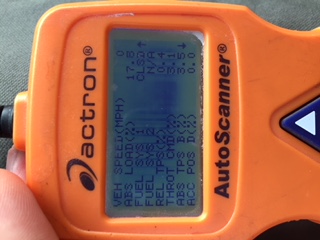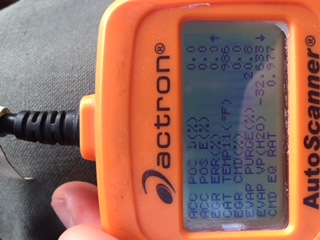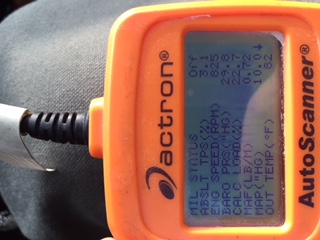Help us help you. By posting the year, make, model and engine near the beginning of your help request, followed by the symptoms (no start, high idle, misfire etc.) Along with any prevalent Diagnostic Trouble Codes, aka DTCs, other forum members will be able to help you get to a solution more quickly and easily!
2005 Buick Lacrosse/ 3800 Series Vin 2- Throttle Actuator Issues
- PK
-
Topic Author
- Offline
- New Member
-

Less
More
- Posts: 6
- Thank you received: 0
7 years 8 months ago #20173
by PK
2005 Buick Lacrosse/ 3800 Series Vin 2- Throttle Actuator Issues was created by PK
Hi all, I am investigating an issue on a 3800 series GM. Unfortunately I recently lost access to my Mitchell on demand account so I have been shooting in the dark while troubleshooting an intermittent throttle actuator problem. Does anyone have a pinout of the connector going to the Throttle actuator controller? It has 13 wires coming out of it (although the connector has more pins that are not used and have dummy plugs in them). In addition, if someone could help me out with a little systems operation that would be great! I have multiple PIDS on my scan tool all relating to throttle control but im not sure which ones relate to the pedal position sensor and what relates to the actuator itself. I figure there is an input from the Accelerator Pedal Position sensor and then some kind of signal from the ECM... also i figure there are multiple potentiometers inside the controller to provide feedback from the stepper motor??? Just guessing though. Anyway just looking for some solid information, I appreciated anything you got!
Paul
Paul
Please Log in or Create an account to join the conversation.
- Ben
-
- Offline
- Platinum Member
-

Less
More
- Posts: 1097
- Thank you received: 215
7 years 8 months ago #20174
by Ben
Replied by Ben on topic Re:2005 Buick Lacrosse/ 3800 Series Vin 2- Throttle Actuator Issues
What codes do you have?
Sent from my SM-N920P using Tapatalk
Sent from my SM-N920P using Tapatalk
Please Log in or Create an account to join the conversation.
- PK
-
Topic Author
- Offline
- New Member
-

Less
More
- Posts: 6
- Thank you received: 0
7 years 8 months ago #20177
by PK
Replied by PK on topic Re:2005 Buick Lacrosse/ 3800 Series Vin 2- Throttle Actuator Issues
Ben, thanks for getting back to me. Unfortunately there are no active codes. At least none that will set the MIL. I have a cheap code reader that is showing nothing active, although a few months back a buddy let me hook up his Verus and I had a P1106 MAP Sensor Circuit Intermittent High in what I can only assume is a historic code. Anyway this whole thing started when I was cruising on the highway about 55-60 and the car would just slightly hiccup, not a heavy buck or anything like that but enough for me to feel. First thing I did was kiss the brake pedal while cruising to disengage and let the torque converter reengage, but that did not recreate the hiccup. Then I noticed that my fuel trims were about -16 to -18 when running down the highway like that and figured I possibly had a lean misfire condition just under cruise conditions like that. Well ironically a few days later my ignition control module died on me... so I replaced that and convinced myself that the old tired ICM was having trouble producing enough KV under the lean cruise conditions and that's why i had the hiccup. So I thought my issue was resolved. Nope, two weeks later the hiccup is back. At this point I figure Ill start by going after that MAP sensor since it was the only thing with a code at one point. So I hook up my scope and drive around for about a week and a half before it decides to act up again. Once it did I was there monitoring my MAP signal and it was not acting any different than it had over the past ten days. So, I decided to move on from the MAP sensor. Then yesterday I went out to start the car and for the first time ever the engine began to surge and buck and barely stay running. My pedal was dead with no response while the engine would rev up to 3 grand and then back down to a low idle and almost quit. I was able to hook up my cheap scanner while it was happening and what i noticed was that the Throttle Command PID and the Absolute Throttle Position PID were not even close to matching. Which made me think the stepper motor was not responding to the commands it had been given. Anyway, after a few minutes it came back into it and has been fine for the past two commutes to school (45 mins each way). I got to thinking that perhaps that MAP code was really just an effect of the Throttle actuator incorrectly allowing more or less air into the manifold (which would then change MAP) , and the computer would see that the throttle position it thought the actuator was at did not match up with the map value it was reading. Sorry to be long winded but wanted to give you all the information Ive got because this problem has been going on for some time intermittently, but it seems to be getting worse. I have heard that I should just go ahead and throw a whole new throttle actuator at it and be done with it but id prefer not to as I am a college student with limited funds! ha, anyway sorry for not giving you this earlier but the engine has 84K on it because it was my grandfathers car and he didn't drive it much before he passed. In all I just wanted to find out what to probe into on that Throttle actuator connector so that I can look at what the stepper motor is being told and how it is responding.
PS. I had the control module off the Throttle actuator last night to have a quick look at the stepper motor gear and shaft for wear but nothing looked unreasonable to me. Not that I have a backlash spec for the thing but ...
Thanks for your time,
Paul
PS. I had the control module off the Throttle actuator last night to have a quick look at the stepper motor gear and shaft for wear but nothing looked unreasonable to me. Not that I have a backlash spec for the thing but ...
Thanks for your time,
Paul
Please Log in or Create an account to join the conversation.
- Ben
-
- Offline
- Platinum Member
-

Less
More
- Posts: 1097
- Thank you received: 215
7 years 8 months ago #20179
by Ben
Replied by Ben on topic Re:2005 Buick Lacrosse/ 3800 Series Vin 2- Throttle Actuator Issues
Ok I think your highway hiccups and your no throttle control are two separate issues well deal with the throttle control first since that is most important. you should have app1 app2 app3 related to your accelerator pedal if any of them doesn't agree you will lose throttle control, I don't remeber what there values should be but it's logic is something like this 1 will start out under 1 volt and climb to almost 5 volts moving pedal from closed throttle to wide open at the same time #2 will start at up close to 5v and come down to under 1 volt at wide open throttle both 1 and 2 should always add up to 5v total (combine 1 and 2 voltage) and I can't remember what 3 done it was a lesser number I believe all on its own . These throttle bodies are pretty picky about being dirty if you haven't cleaned it now would be a good time to go ahead and do that the absolute throttle position is cut and dry it's just the position of the throttle blade at idle I believe were somewhere around 12% I don't remember exactly but a dirty throttle body will have a higher %at idle than a clean 1.
Sent from my SM-N920P using Tapatalk
Sent from my SM-N920P using Tapatalk
Please Log in or Create an account to join the conversation.
- PK
-
Topic Author
- Offline
- New Member
-

Less
More
- Posts: 6
- Thank you received: 0
7 years 8 months ago #20207
by PK
Replied by PK on topic Re:2005 Buick Lacrosse/ 3800 Series Vin 2- Throttle Actuator Issues
Ben,
Thanks again for your input. I figured there were at least two separate potentiometers in the APPS for redundancy, and I had seen in the past that the two operated inversely of each other. I was able to dig a little deeper into some internet research today and came across this awesome video (see below) that verifies your thought that there are 3 separate pot signals in the APPS; however, I have the Type 3 system. Which it does not explicitly label the corresponding APPS signal picture, but I assume when they say "early systems had 3 signals" it means my Type 3 will have the 2 signal sensor. I was also amazed that they are pulling the Vref signal to ground at a fixed frequency on the second APP signal! I can only assume that they are doing that to more or less create a Digital input from an Analog one because they are effectively "sampling" the signal value at that frequency... not sure what benefit that provides but cool to see! I am going to probe my APPS in the next day or two to confirm this but I also noticed today on my scan data that there is only two PIDS labeled ACC (D and E) while the other PIDS (ABS TPS and REL TPS) seem to be the pots built into the Throttle Actuator Controller up at the valve itself. Anyway, I actually did clean my whole throttle assembly about 10k miles ago for no reason other than just typical maintenance when I inherited the car. I believe at the time my idle TPS reading was somewhere between 9-12??? I think I wrote it down in my service notes but I will have to double check for you. Regardless, once I conducted the cleaning (which it needed) I actually brought the idle TPS reading down to about 2 or 3, so it definitely made a difference. I have attached a photo of my little scan data read out from this morning (car hot and idling at the end of my commute). I guess my question at this point is, do I go after the APPS for an intermittent drop out? Or does it seem like an issue on the TAC side? Keep in mind monday afternoon was the very first time it had trouble idling at startup and for a few minutes had little to no response to the pedal input... just acting wild and crazy for a few minutes before I cycled the key off and it came out of it. One other little tidbit is that monday afternoon it rained extremely hard while my car was just sitting out in a parking lot, which doesn't seem like a big deal but I do park it in my garage every night so it doesn't see a whole lot of moisture for the most part... just something that crossed my mind. I also came across a post on a forum today about a fuse that powered the TAC being corroded and creating kinda similar symptoms to what I have. I guess the TAC was effectively turning on and off intermittently from the high resistance on the power supply, but I just breezed over the post so I forget the details. Again thanks for your time, hopefully we can make some progress on this thing!
PS. One other thing I was looking into today was the difference between REL TPS and ABS TPS. From what I gathered Relative is the learned value, or the calibrated value I assume. Im not for certain, but when I used to work in the heavy equipment world we would have to calibrate a new tps when we put it on so that the computer could see the whole pedal sweep, and I was told that was because the linkage of the pedal may not allow the pot to sweep entirely the length of its carbon strip, which would mean you could be at full throttle demand but only read 80% or something like that. But once the calibration is conducted the computer learns that 80% of the pot is physically 100% of the pedal travel. So I assume its similar to this but if you have any input Id love to hear it!
Thanks,
Paul
Thanks again for your input. I figured there were at least two separate potentiometers in the APPS for redundancy, and I had seen in the past that the two operated inversely of each other. I was able to dig a little deeper into some internet research today and came across this awesome video (see below) that verifies your thought that there are 3 separate pot signals in the APPS; however, I have the Type 3 system. Which it does not explicitly label the corresponding APPS signal picture, but I assume when they say "early systems had 3 signals" it means my Type 3 will have the 2 signal sensor. I was also amazed that they are pulling the Vref signal to ground at a fixed frequency on the second APP signal! I can only assume that they are doing that to more or less create a Digital input from an Analog one because they are effectively "sampling" the signal value at that frequency... not sure what benefit that provides but cool to see! I am going to probe my APPS in the next day or two to confirm this but I also noticed today on my scan data that there is only two PIDS labeled ACC (D and E) while the other PIDS (ABS TPS and REL TPS) seem to be the pots built into the Throttle Actuator Controller up at the valve itself. Anyway, I actually did clean my whole throttle assembly about 10k miles ago for no reason other than just typical maintenance when I inherited the car. I believe at the time my idle TPS reading was somewhere between 9-12??? I think I wrote it down in my service notes but I will have to double check for you. Regardless, once I conducted the cleaning (which it needed) I actually brought the idle TPS reading down to about 2 or 3, so it definitely made a difference. I have attached a photo of my little scan data read out from this morning (car hot and idling at the end of my commute). I guess my question at this point is, do I go after the APPS for an intermittent drop out? Or does it seem like an issue on the TAC side? Keep in mind monday afternoon was the very first time it had trouble idling at startup and for a few minutes had little to no response to the pedal input... just acting wild and crazy for a few minutes before I cycled the key off and it came out of it. One other little tidbit is that monday afternoon it rained extremely hard while my car was just sitting out in a parking lot, which doesn't seem like a big deal but I do park it in my garage every night so it doesn't see a whole lot of moisture for the most part... just something that crossed my mind. I also came across a post on a forum today about a fuse that powered the TAC being corroded and creating kinda similar symptoms to what I have. I guess the TAC was effectively turning on and off intermittently from the high resistance on the power supply, but I just breezed over the post so I forget the details. Again thanks for your time, hopefully we can make some progress on this thing!
PS. One other thing I was looking into today was the difference between REL TPS and ABS TPS. From what I gathered Relative is the learned value, or the calibrated value I assume. Im not for certain, but when I used to work in the heavy equipment world we would have to calibrate a new tps when we put it on so that the computer could see the whole pedal sweep, and I was told that was because the linkage of the pedal may not allow the pot to sweep entirely the length of its carbon strip, which would mean you could be at full throttle demand but only read 80% or something like that. But once the calibration is conducted the computer learns that 80% of the pot is physically 100% of the pedal travel. So I assume its similar to this but if you have any input Id love to hear it!
Thanks,
Paul
Please Log in or Create an account to join the conversation.
Time to create page: 0.340 seconds



